

Birding Map of Kruger Park Central Grasslands
- The Central Grasslands
- Orpen Gate to Satara
- Orpen Gate to Olifants
- Satara Area
The Largest Hornbill
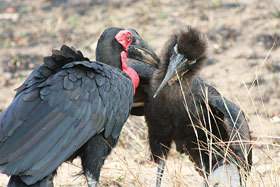 The dawn call of the Southern Ground-Hornbill is one of wild Africa's most engaging sounds. It has a booming voice, which has been likened to the roar of a lion. An African interpretation of duets between birds is that the female calls, 'I am going, I am going, I am going to my relations', to which the male replies, 'You can go, you can go, you can go to your relations'.
The dawn call of the Southern Ground-Hornbill is one of wild Africa's most engaging sounds. It has a booming voice, which has been likened to the roar of a lion. An African interpretation of duets between birds is that the female calls, 'I am going, I am going, I am going to my relations', to which the male replies, 'You can go, you can go, you can go to your relations'.
The Southern Ground-Hornbill is a potent bird in indigenous folklore. This large, distinctive bird is believed to have powerful muthi that can either bring rain or prevent lightning strikes. For this reason, it is targeted by poachers who can get high prices for its beak and other body parts. The species has become vulnerable to extinction in southern Africa.
There are between 600 and 700 Southern Ground-Hornbills in Kruger, occurring in small groups in a variety of woodland savanna habitats, except where there are no trees. Southern Ground-Hornbills sleep in trees and descend to the ground at dawn to spend the day foraging. They have a wide diet ranging from termites and other insects, to frogs, tortoises, small snakes, squirrels and mongooses.
They can walk up to 11km a day looking for prey, which they sometimes hunt communally, trying to flush it in the direction of other group members. Or they might surround a log or bush where a small animal may be hiding. Only the monogamous alpha pair breed, while the other birds help look after the young. See "Nghututu" the vulnerable.
There is an ongoing census and study of the Southern Ground-Hornbill in Kruger and it is becoming clear that safe nesting sites determine the population balance. Authorities have appealed to the public to report any sightings, with the date, exact location, time of day, number of birds and their condition.
Undertaker of the Bush
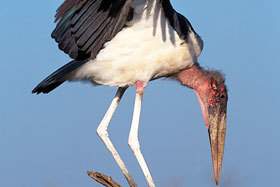 The Marabou Stork is known as the 'Undertaker of the Bush' because of its solemn demeanour and ability to clean up any dead or dying animals. It seeks out veld fires because panicking animals fleeing the flames are easy prey. In Nguni folklore, the Marabou Stork is known as the 'King Vulture' because of its size and scavenging skills.
The Marabou Stork is known as the 'Undertaker of the Bush' because of its solemn demeanour and ability to clean up any dead or dying animals. It seeks out veld fires because panicking animals fleeing the flames are easy prey. In Nguni folklore, the Marabou Stork is known as the 'King Vulture' because of its size and scavenging skills.
It is the largest Stork - an adult stands about 1.5m high and weighs about 6 kg. It requires up to a kilogram of food a day to stay in shape. The Marabou's sharp bill, bare head and neck indicate how it has evolved as a carrion-feeding specialist.
These storks may gather in large numbers - veteran Kruger bird researcher JC Kemp once counted about 200 birds on an elephant carcass. They also come out in force at termite emergences. In the natural hierarchy, the Marabou accepts subordination to large eagles and vultures although it won't pass the opportunity to eat a vulture if it can.
It uses its beak as a stabbing spear. There are reports from East Africa of Marabous getting in amongst huge flocks of flamingoes at pans, stabbing and drowning the disabled birds, disembowling them and then feasting. The Marabou preys on its own kind - the White, Abdim's and Woolly-necked Storks - as well as a variety of other birds and small animals like rats and mice.
It raids Red-billed Quelea colonies, sneaks up on crocodile lairs to eat both crocodile eggs and hatchlings, and gathers at drying pools to prey on dying fish. Marabous are high flyers. They are known to catch thermal updrafts up to 1.5km above the veld, and on these occasions may spend much of the day soaring. Males have a neck pouch that becomes inflated during breeding season.
They also have a curious habit of defecating on their own legs to cool themselves down on hot days - the white colour of their faeces acts as a reflector so their normally black legs don't absorb excessive heat. The Marabou Stork population has been greatly influenced by tourism in Kruger.
The birds used to feed off the rubbish dumps at camps but since the Park changed its waste disposal system, Marabou numbers have declined. It's not clear to what extent they are resident in Kruger. Traditionally they are known as intra-African summer migrants, but Roberts VII estimates there may be 300-400 adults living in Kruger. The Marabou is classified as a near-threatened species in southern Africa.
ORPEN CAMP
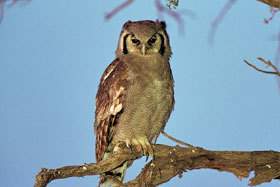 Orpen Camp is a small camp at Orpen Gate well-suited for late arrivals in the Park. Camp-organised night drives are recommended as Orpen has a reputation for excellent sightings of nightjars and owls including the little Pearl Spotted and African Barred-Owlets as well as the larger African Scops-Owl, Verreaux's and Spotted Eagle-Owl. Marsh and African Grass-Owls are rarer sightings at dusk at Orpen.
Orpen Camp is a small camp at Orpen Gate well-suited for late arrivals in the Park. Camp-organised night drives are recommended as Orpen has a reputation for excellent sightings of nightjars and owls including the little Pearl Spotted and African Barred-Owlets as well as the larger African Scops-Owl, Verreaux's and Spotted Eagle-Owl. Marsh and African Grass-Owls are rarer sightings at dusk at Orpen.
In Orpen camp itself, a special sighting is the Plain-backed Sunbird, a yellowish bird with the male having a dark blue throat and forehead. The Orpen area is usually reliable raptor and vulture territory. One of the most common sightings is the Tawny Eagle, which reportedly nests near the camps.
Cape Vultures breed in the crags of the berg 50km due west near Strydom Tunnel, but often come into the Park to feed. The Bateleur is common, as are most of the larger eagles.
MAROELA AND TAMBOTI CAMPS
 Maroela Camp and Tamboti are adjoining camps a few kilometres from Orpen Gate. They cater mainly for campers and caravaners. Maroela has 19 camping sites and two huts that can sleep eight people. There are communal ablution and cooking facilities.
Maroela Camp and Tamboti are adjoining camps a few kilometres from Orpen Gate. They cater mainly for campers and caravaners. Maroela has 19 camping sites and two huts that can sleep eight people. There are communal ablution and cooking facilities.
Tamboti is a camping site with permanent tents. Reception for both camps is at Orpen Gate, where any shopping must be done as there are no shops at either camp. Both camps overlook the Timbavati Riverbed and are surrounded by wonderful, riverine woodland with abundant birdlife in the Leadwoods, Sycamore Figs, acacias and bushwillows.
The secretive Olive Bush-Shrike is a Tamboti Tented Camp special and pairs are often seen feeding in the lower strata of the bush. In wet seasons, there are usually visits by the uncommon Black Coucal.
This is believed to be the southernmost sighting point of the Tropical Boubou, which has less cinnamon on its underparts than the more common Southern Boubou. The Great-spotted Cuckoo is sometimes seen around Tamboti and Maroela.
Main Orpen-Satara Road (H7)
The main Orpen-Satara Road (H7) runs through thornveld with mixed grassland. There are large pockets of sweet grass along the entire road to Satara, which makes it a good game drive. buffalo are usually plentiful.
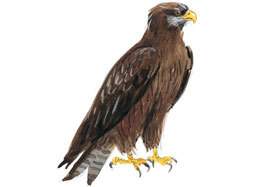 N'wamatsatsa Water Hole is seven kilometres from Orpen. Marabou Storks may be seen here, particularly when there are lots of queleas in the Park. The most common raptor in summer is the Yellow-billed Kite, while surprises such as Montagu's Harrier are occasionally seen along this stretch of the road.
N'wamatsatsa Water Hole is seven kilometres from Orpen. Marabou Storks may be seen here, particularly when there are lots of queleas in the Park. The most common raptor in summer is the Yellow-billed Kite, while surprises such as Montagu's Harrier are occasionally seen along this stretch of the road.
Just off the Orpen-Satara road on the S106 is Rabelais Hut - a modest museum from the old ranger's hut, now frozen in time. Rabelais was one of the farms donated by Eileen Orpen to Kruger. The farm itself was named after Francois Rabelais, the 16th-century French alchemist monk and satirist, who once remarked, for what it's worth, that failure after a great deal of effort was like 'beating the bush without taking the birds'.
The pan at Rabelais has been eliminated because of new Park guidelines on water sources. When the vlei was still in existence it was the first recorded Kruger breeding site of the Greater Painted-snipe (1999), a rare Kruger sighting as the bird seems to be extremely nomadic, following the rain fronts across southern Africa. It is easily identified by whitish eye-rings, which give it the appearance of wearing fake, comic glasses.
Masala and Bobbejaankrans Lookout Points are the only direct access to the Timbavati along the H7 and both are reasonable view sites. There are often White-fronted Bee-eaters and a variety of kingfishers to be seen along the river itself.
The H7 allows one the option of heading north along the Timbavati River Road (S39), heading south towards Nhlanguleni Picnic Site, or pressing on towards Satara. All routes go through the central grasslands, which are renowned for raptors. Just south of the Orpen-Satara Road, near the Timbavati turn-off, is a long stretch of seepline drainage that becomes a bird-rich vlei area after summer rains.
Regular sightings of the larger birds of prey include the African Hawk-Eagle, Martial, Wahlberg's, Steppe and Lesser Spotted Eagles, the Brown Snake-Eagle and the Bateleur. Smaller raptors include the Black-shouldered Kite, Little Sparrowhawk and the Gabar Goshawk.
 Raptors are particularly active here after the rains when termites emerge from their subterranean lairs, provoking large feeding frenzies. Another big food source are the millions of Red-billed Queleas that descend in huge flocks on the central plains during their nomadic trips across the subcontinent. Nsemani Dam, 6km west of Satara on the H7, is usually reliable for waterbirds such as the Hottentot Teal, White-backed and Fulvous Ducks.
Raptors are particularly active here after the rains when termites emerge from their subterranean lairs, provoking large feeding frenzies. Another big food source are the millions of Red-billed Queleas that descend in huge flocks on the central plains during their nomadic trips across the subcontinent. Nsemani Dam, 6km west of Satara on the H7, is usually reliable for waterbirds such as the Hottentot Teal, White-backed and Fulvous Ducks.
 Where to stay in Central Grasslands
Where to stay in Central Grasslands
- Orpen Rest Camp
- Maroela Private Camp
- Satara Rest Camp
- Tamboti Tented Camp
- Talamati Bushveld Camp
Birds Hate Snakes
Kruger birder Chris Patton once recorded 11 different bird species mobbing a boomslang in the tree next to Cottage 5 at Talamati Camp (see Talamati Camp below). They were the Crested Barbet, Southern Black Tit, Dark-capped Bulbul*, Green-backed Camaroptera, Chinspot Batis, Black-backed Puffback, Brown-crowned Tchagra, Orange-breasted Bush-Shrike, Burchell's Starling, Blue Waxbill and Red-billed Firefinch.
TALAMATI CAMP
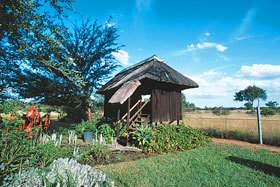 Talamati is a small bushveld camp in the mixed woodlands of the N'waswitsontso watercourse. There are six self-catering cottages with no other facilities, although there is a public phone at reception.
Talamati is a small bushveld camp in the mixed woodlands of the N'waswitsontso watercourse. There are six self-catering cottages with no other facilities, although there is a public phone at reception.
The camp is on the edge of the N'waswitsontso wetlands, which ensures there is usually good all-year-round birding. The sandy river feeds the Mluwati Concession before snaking its way down to Orpen Dam and on to Mozambique through the Lebombo.
There are two bird hides at Talamati, one of which overlooks a water hole near the reception area. Saddle-billed Storks are a camp speciality - they breed nearby. Other storks often seen here include the Woolly-necked, White and Black Storks and the African Openbill*.
In summer, the African Cuckoo's call is common during the day around Talamati, while the African Scops-Owl is the night bird most often heard. An unusual occurance at Talamati was the sudden appearance - and death - of a Narina Trogan that flew into the window of one of the cottages in 2001. This species is not usually seen in the central grassland.
Fairfield Water Hole is accessible only to residents at Talamati and the Mluwati Concession lodges. The marshy areas around Fairfield often have interesting summer waterbird sightings, including the African Crake.
MLUWATI CONCESSION
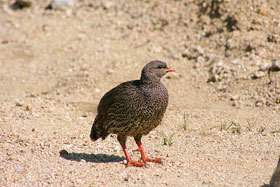 The Mluwati Concession is a 10 000ha private reserve east of Talamati some 40km from Orpen Gate. The area is mixed woodland dominated by bushwillows and acacias with swathes of open grassland. There are pockets of dense riverine bush along the N'waswitsontso and Mluwati rivers.
The Mluwati Concession is a 10 000ha private reserve east of Talamati some 40km from Orpen Gate. The area is mixed woodland dominated by bushwillows and acacias with swathes of open grassland. There are pockets of dense riverine bush along the N'waswitsontso and Mluwati rivers.
Sweeter grass grows on the lower contours, so game viewing is best along the drainage lines and watercourses of this gentle, rolling landscape. Mluwati is the home of the Double-banded Sandgrouse. Easily identified by the black band across its white forehead, the two bands across its chest and its yellow beak, the Double-banded Sandgrouse does very well in this habitat.
At dusk and dawn it utters a rapid conversational call - weep-weeu, chuk-chukki, weep-weeu which some claim sounds like, 'oh NO he's gone and done it aGAIN'. Occasionally the Peregrine Falcon is seen over the Mluwati - it has a particular fondness for sandgrouse. For its part, the Double-banded Sandgrouse keeps a low-profile during the day, emerging noisily when flushed from the side of the road during game drives. It is an ideal habitat for the Natal Spurfowl*.
Most of the bigger grassland birds are found at Mluwati such as the Kori and Black-bellied Bustards* and the Red-crested Korhaan.
IMBALI
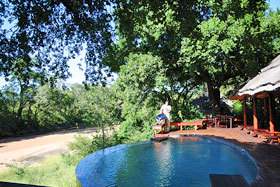 Imbali was the original lodge in the Concession. It has 12 unashamedly upmarket, luxury suites overlooking the N'waswitsontso River. The camp is built close to an excavated hunter-gatherer camp dating back several hundred years. Iron-Age artifacts found in the area have been built into special display units at Imbali, an aesthetic blend of stone and wood.
Imbali was the original lodge in the Concession. It has 12 unashamedly upmarket, luxury suites overlooking the N'waswitsontso River. The camp is built close to an excavated hunter-gatherer camp dating back several hundred years. Iron-Age artifacts found in the area have been built into special display units at Imbali, an aesthetic blend of stone and wood.
There is good birding from the entertainment deck and pool at Imbali as many woodland species flit through the tall trees around the camp.
HAMILTON'S TENTED CAMP
Hamilton's probably rivals Singita Lebombo as the most romantic place to stay in Kruger. It has six intimate luxury tents overlooking the long finger of N'waswitsontso Dam, which is a kingfisher highway. Each tent has its own plunge pool, outdoor shower and private verandah. The aesthetic is early 20th-century safari, evident in the wood and canvas décor of the public area. The camp is unfenced and animals wander freely through the area.
HOYO HOYO TSONGA VILLAGE
Hoyo Hoyo is one of the most interesting architectural experiences in the Park. It is designed as a contemporary interpretation of a traditional Shangaan/Tsonga village.
There are six luxury, African fantasy huts overlooking the Mluwati River, each fitted with sophisticated modern finishings. The ethnic plushness of Hoyo Hoyo is radically different from the more traditional Kruger experience and is geared towards the sophisticated traveler.
Game drives may only be done in lodge vehicles. None of the Mluwati Concession camps accept children under eight unless the entire camp is booked out by a single party. The Mluwati Concession is very good for winter game viewing and day-time owl viewing - particularly the Verreaux's Eagle-Owl, Pearl-spotted Owlet and African Scops-Owl which are regularly seen on game drives.

